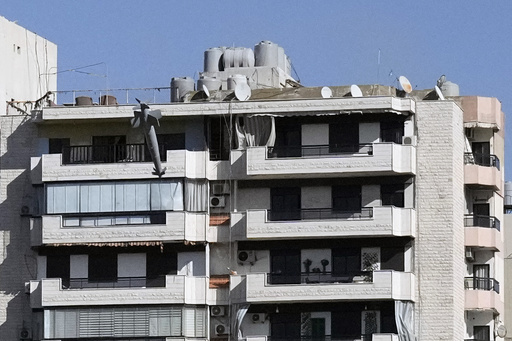
JERUSALEM — In a dramatic moment captured by an Associated Press photographer, an Israeli bomb in a battleship-gray hue descended upon a building in Beirut, resulting in its collapse upon detonation.
This airstrike was executed just 40 minutes after Israel issued a warning to evacuate two nearby buildings, claiming they were situated close to Hezbollah’s storage facilities and assets. The attack location was also near a recent press briefing held by a spokesperson for the militant group.
This incident provided a rare opportunity to observe the deployment of one of Israel’s most advanced munitions.
What type of weapon was utilized in this strike?
Investigations by independent arms specialists indicate that the weapon was likely a guided bomb, commonly referred to as a smart bomb, and was launched from an Israeli fighter jet.
According to Richard Weir, a senior researcher at Human Rights Watch focused on conflict and arms issues, details such as the tail fin and nose sections suggest that it was a 2,000-pound warhead equipped with an Israeli-designed guidance kit known as SPICE.
The SPICE, which stands for Smart, Precise-Impact and Cost-Effective, is manufactured by Rafael Advanced Defense Systems, a state-owned company in Israel. These guidance systems are attached to standard unguided bombs to help them reach their specified targets accurately.
Prior to the main strike that demolished the building, there were two smaller preliminary strikes aimed at it, a tactic often referred to by the Israeli military as a “knock on the roof” warning. This tactic has been noted in previous Israeli military operations, such as in Gaza, where civilian and combatant casualties have been extensive, with over 40,000 reported dead according to local officials.
The Israeli military has not commented on the specific weapon used in this incident.
Why does Israel opt for this type of munitions?
Rafael promotes SPICE kits as operable under various conditions, including day or night, poor weather, and in environments where GPS signals might be jamming. The company claims these weapons offer “high lethality and low collateral damage” as well as “pinpoint hit accuracy.”
Additionally, this type of bomb allows attacking aircraft to maintain a safe distance from the target, as the 2,000-pound bomb can be deployed up to 60 kilometers (about 37 miles) away. Rafael also manufactures smaller variants of these bombs.
Once launched by Israeli warplanes, which include American-made F-15 or F-16 aircraft, the bomb utilizes movable fins to glide toward its designated target.
Joseph Dempsey, a military analyst with the International Institute of Strategic Studies, confirmed that the visuals support the identification of the munition as a 2,000-pound SPICE bomb.
He further noted that the guidance system likely utilizes both GPS tracking and electro-optical guidance systems, which rely on cameras or sensors to precisely home in on the target.
The bomb’s destructive power results from several factors, including the warhead’s size and the fusing technology used.
“This was clearly a delayed action fuse that penetrated underground before detonating, which minimizes the fragmentation and blast radius from this specific strike,” Weir explained. This would clarify why damage was primarily contained to the targeted structure, with minimal impact reported by individuals several hundred meters away from the scene.
Where are these bombs manufactured?
The answer is complex.
“The SPICE 2000 guidance kits are created by Rafael in Israel, though the extent of reliance on foreign components remains uncertain,” Dempsey elaborated. In 2019, Rafael partnered with U.S. defense contractor Lockheed Martin to produce and market SPICE guidance kits in the United States. During that time, it was revealed that more than 60% of the SPICE system’s production was spread across eight U.S. states.
In late October 2023, subsequent to Hamas’ assault on October 7, the U.S. State Department approved an export request for additional SPICE bomb components to Israel. This request was unveiled earlier by a major news outlet and reported a $320 million shipment being sought by Rafael USA, a subsidiary of Rafael in the U.S., which amended a prior $403 million license from 2020.
The bomb itself is essentially a basic explosive device, likely a 2,000-pound MK-84 model, with the guidance system replacing its nose and tail sections.
Earlier this year, the U.S. halted the delivery of these potent munitions to Israel over concerns about civilian safety, although it is believed that Israel has retained stockpiles.
The origins of the bomb components are not easy to determine definitively. While Israel relies on the U.S. for MK-84 bomb supplies, the capability to produce similar munitions exists within other countries as well.
Establishing the specific production location would necessitate the recovery of bomb fragments that have identifiable markings, Weir noted.
